Let me show you how to roast a perfect prime rib, step by step, with proven, fool-proof method using reverse sear technique as seen on Serious Eats.
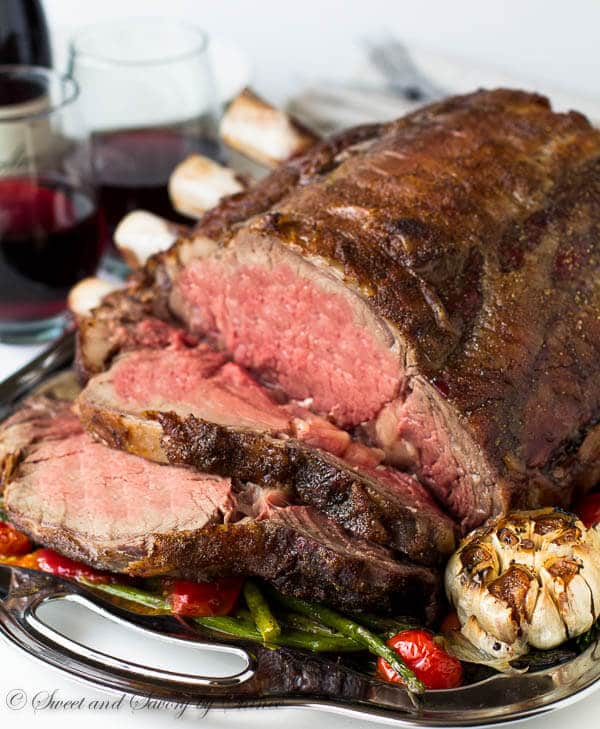
Table of Contents
- This is the Best Prime Rib recipe!
- Prime Rib Roast Ingredients
- What’s reverse searing method?
- How to cook Prime Rib
- Should you salt prime rib before cooking?
- What is the best temperature to cook a prime rib roast?
- Should prime rib be cooked covered or uncovered?
- How to serve Bone in Prime Rib
- How to store Prime Rib of Beef
- Cooking Prime Rib FAQ
- More Recipes You’ll Love
- Best Prime Rib of Beef Recipe
- If you have have a boneless prime rib, check out this post:
Oh my gosh, do I love me some prime rib!! Thick, juicy and melt-in-your-mouth tender, there is nothing better than perfectly cooked prime rib.
If you’d asked me “How would you like your steak?” like 10 years ago, when I just landed in the U.S., I’d tell you firmly, “Well done.” Cringe, cringe, I know!! Though we eat a lot of beef in Mongolia, steak isn’t common there. And we’re just not accustomed to pink meat. In fact, it took me good 2 years to start ordering medium done steaks. That’s when I met my rancher husband, who wouldn’t let me order well done (aka ruined) steaks.
Fast forward 8 years, I now cook medium and sometimes even medium rare steaks for myself. Oh how things change!
This is the Best Prime Rib recipe!
Every year at Christmas, my family serves a perfectly cooked standing rib roast with a deep brown crust and a bright red center. It’s a thing of beauty, with ooh’s and aah’s all around.
It’s intimidating to cook this expensive cut but fear not! I’m here to share a foolproof method to cook a perfect prime rib roast no matter your level of cooking expertise (or lack thereof). It’s thick, juicy, and melt-in-your-mouth tender!
- Reverse-searing method ensures even cooking
- Customize with your favorite seasoning
- Make it ahead: cook it couple of hours early and then sear it right before serving!
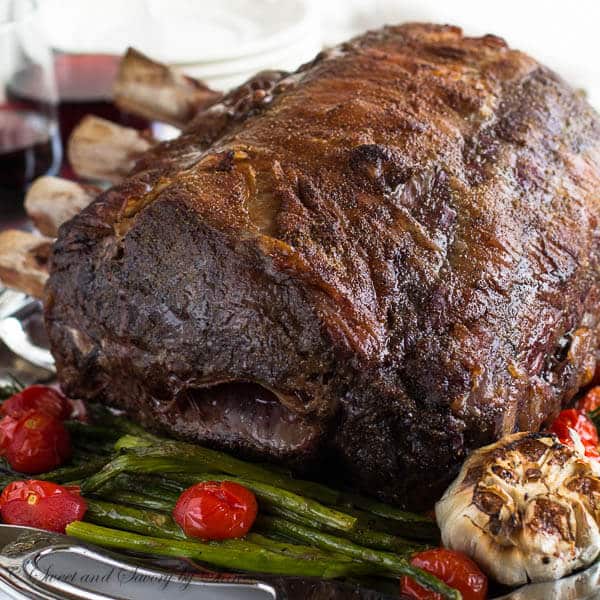
Prime Rib Roast Ingredients
- Prime rib: Prime rib is a cut from the primal rib section of the cow (hence the name). It’s also referred to as a standing rib roast, rolled rib roast, or rib-eye roast. I recommend purchasing bone-in prime rib for the best flavor and melt-in-your-mouth texture. Look for a 4-rib roast that weighs around 5 to 10 pounds. Each rib will feed 2 to 3 people, depending on the number of sides you plan to serve.
- Kosher salt: A tablespoon of salt may seem hefty but trust me on this. Salt equals flavor! And you want plenty of salt on your gorgeously crisp crust. It also ensures the interior will be succulent and not dry or tough.
- Spices: Cumin, black pepper, and garlic powder are a tasty trio, but you can use whatever spices you love! Herbs de Provence, rosemary, thyme, and sage are good options too. Or omit the spices altogether and just go with salt.
What’s reverse searing method?
When you have this beautifully marbled, perfectly frenched prime rib, you don’t want to mess up, especially if you’re making it for a special occasion. But don’t let the fear stop you from serving this masterpiece for a holiday meal. I’m going to show you a fool-proof, proven method to roast a perfect prime rib!
Now, listen read closely…
You’ve probably heard of searing the meat before roasting to lock in the juices, right? And no doubt, there’s place and time for that trusty technique, but when it comes to roasting a prime rib, that’s not really an ideal method. And I’m not just a crazy lady talking crazy things on the internet.
- Deep brown, crispy exterior.
- Minimum overcooked layer between the crust and interior, aka gray zone.
- Maximum juiciness.
He achieved all three criteria by reverse searing method. What is reverse searing, you ask?
Well, that’s when you cook the prime rib at the very low temperature until it reaches 120°F for medium rare, and then you roast it at the very high temperature for a short period of time. But here’s the important part: before searing at high temp, you’ll need to take the roast out of the oven and let it rest while oven is preheating to 500°F. This way, the roast won’t overcook, because as you know, it takes at least 20 minutes to heat an oven to that high temp, plenty of time to ruin a good roast!
How to cook Prime Rib
- The night before:
- Unwrap the prime rib and place it on a tray that will fit in your fridge. Generously salt all over the roast and refrigerate it, uncovered, overnight to air-dry the outside of the prime rib. This is crucial step for 2 reasons: salt will penetrate deep into the roast during this time and the roast will dry out and develop a nice crust.
- Prepare:
- Preheat the oven to 200°F (95°C).
- Mix the cumin, black pepper and garlic powder and evenly spread all over the meat.
- If roasting garlic, slice the top off, drizzle some olive oil and wrap in foil.
- Roast:
- Place the prime rib on a roasting pan, bone-side down.
- Roast the meat in the oven until the center of the roast reads 120°F (50°C) on a meat thermometer for medium-rare, or 130°F (55°C) for medium doneness, about 3.5-4 hours. It’s crucial to temp your roast! If you simply go by length of time in the oven, you may overcook it.
- Rest:
- Remove the prime rib from the oven, cover with foil, and let it rest for at least 30 minutes or up to 2 hours.
- Sear:
- Increase the oven temperature to 500°F (260°C).
- Uncover the prime rib and put it back into the oven. Cook it until it’s deep brown, and crisp on the outside, about 6-10 minutes. If desired, roast the cherry tomatoes and asparagus together.
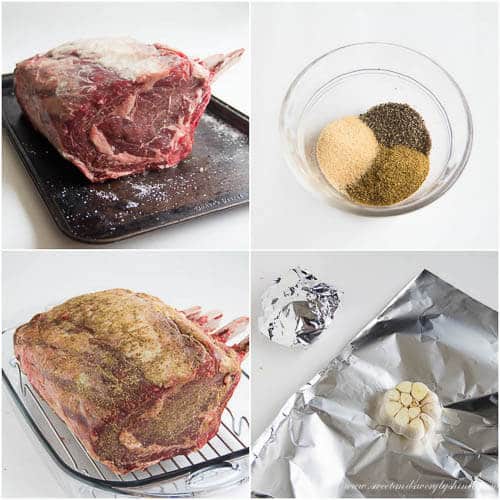
Tip
For perfectly crispy crust, make sure to dry out the roast by resting it uncovered in the fridge overnight.
And while at it, go ahead and salt it too, so that it has plenty of time to penetrate the meat all the way inside.
Should you salt prime rib before cooking?
It’s crucial to liberally salt the prime rib before you plan to cook it. It does more than just add flavor. It draws moisture to the surface of the meat which dissolves the salt. Why does this matter? It ensures the center will be juicy and not dry! It acts like a brining liquid without sacrificing the crispy exterior. The moisture reabsorbs into the meat and leaves you with a flavorful, tender roast.
What is the best temperature to cook a prime rib roast?
I highly recommend medium-rare for the best prime rib! It will be tender and juicy at this stage. If it’s overcooked, it will taste dry, tough, and chewy. I wouldn’t recommend cooking it past medium. For a medium-rare roast, cook to an internal temperature of 120 degrees. The roast’s temperature will continue to rise as you pull it out of the oven, and you don’t want it to overcook.
Should prime rib be cooked covered or uncovered?
Prime rib should be cooked uncovered. In this reverse-sear method, the roast is cooked at a low oven temperature, then “seared” at 500 degrees until crisp and deep brown. You don’t want to hinder the hot heat from crisping the crust.
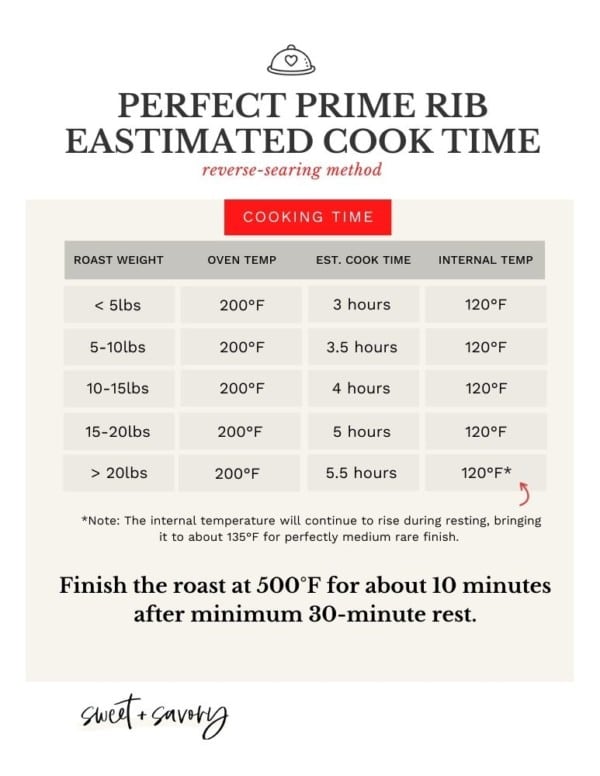
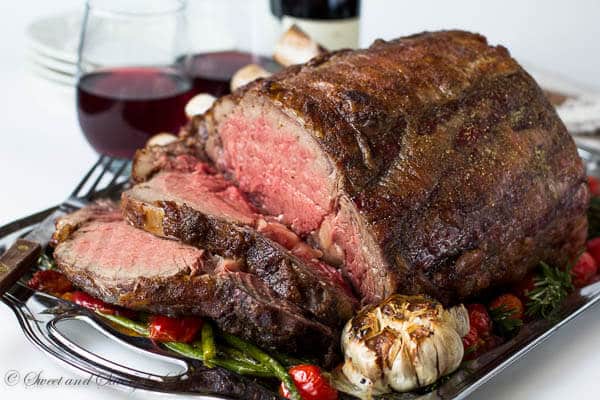
How to serve Bone in Prime Rib
The table is set, the roast is done, and your guests are salivating! Now what? It’s time to cut the roast into slices and serve. You can estimate 2 people per pound for a large portion, or 3 people per pound for a small portion.
I like to err on the side of caution and guestimate 2 people per pound. However, if you have enough sides to feed an army, you may be fine with more.
How to carve the roast
- Find a stable and large cutting board that fits the entire roast. If your cutting board slides around, place a towel underneath it to stabilize it.
- First use a boning knife to remove the bones. Hold the roast by the bones with one hand and carefully slide the boning knife directly behind the bones. Cut all the way done until the bones release from the meat.
- Lay the roast on the cutting board and use a sharp chef’s knife or santoku to slice the roast into ½ inch thick slices.
- Transfer the slices onto a serving platter and enjoy!
How to store Prime Rib of Beef
Wrap leftover prime rib in plastic wrap and refrigerate for up to 5 days. If possible, leave the leftover roast unsliced and slice before you plan to serve it.
Reheat the roast in the oven at 250 degrees. Place the roast in a baking dish, add a splash of beef broth, and cover. Cook until the roast or slices are reheated through.
If you don’t mind losing the rosy interior, you can microwave the prime rib until hot.
Cooking Prime Rib FAQ
It depends on the size of your roast and the accuracy of your oven! It’s best to temp the roast so you don’t accidentally overcook it. A 4-rib roast took approximately 3.5 to 4 hours to come to an internal temperature of 120 degrees Fahrenheit (medium-rare). It will take even longer to reach medium.
Prime rib and a rib roast are both cut from the primal rib section, specifically the 6th through 12th ribs. Prime rib has the bones intact and in a rib roast they are removed. The rib roast is often cut into ribeye steaks for grilling.
You can count on one pound of bone-in prime rib roast serving two adults. That’s about one bone per two adults, so a 4-rib prime rib serves about 8 people. If you have plenty of side dishes or light eaters, you can stretch it to 3 people per pound of meat.
Both are delicious! I recommend bone-in prime rib though because it’s harder to overcook. The bones insulate the meat for a juicy and tender finish. The main benefit to a boneless prime rib is it’s easy to carve.
They are both from the primal rib section of the cow, but a prime rib is a large roast made up of 4 to 7 ribs. If you cut the roast into steaks, then you would have ribeye’s! A prime rib is roasted whole in the oven, typically on low heat, then sliced. A ribeye is already cut into an individual steak and is grilled or seared over high heat.
Let me know if you try this method. I know you won’t regret it.
Thank you for reading!
More Recipes You’ll Love
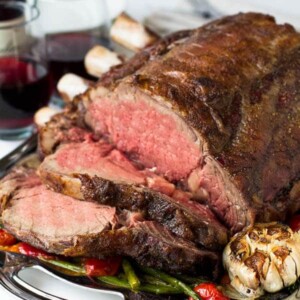
Best Prime Rib of Beef
Ingredients
- 5-10 lbs (or 4-rib) prime rib
- 1 tablespoon coarse kosher salt
- 2 teaspoons ground cumin
- 1 teaspoon ground black pepper
- 1 teaspoon garlic powder
Optional Add-Ins:
- A head of garlic
- Cherry tomatoes
- Asparagus
Instructions
Prep:
- Place an unwrapped prime rib on a tray. Generously salt all over and refrigerate overnight to air-dry the outside of the prime rib.
- Bring the prime rib to room temperature before roasting. It usually takes about 2 hours out on the counter.
- Mix the cumin, black pepper and garlic powder and evenly spread all over the meat.
- If roasting garlic, slice the top off, drizzle some olive oil and wrap in a foil. (Here's my detailed roasted garlic recipe.)
Roast:
- Preheat the oven to 200°F (95°C).
- Place the prime rib on a roasting pan bone side down (fat side up). (Since I wrote this post, I bought this roasting pan, and highly recommend it.)
- Roast the meat in the oven until the center of the roast reads 120°F (50°C) on a meat thermometer for medium-rare, or 130°F (55°C) for medium doneness, about 3.5-4 hours. (This Thermapen Mk4 meat thermometer is my favorite! Super quick and reliable! <- affiliate link)
Rest:
- Remove the prime rib from the oven, cover with a foil and rest for about 30 minutes.
Sear:
- Increase the oven temperature to 500°F (260°C).
- 10 minutes before serving, pop the prime rib into the oven, uncovered, and cook it until it’s nice and brown, and crisp on the outside, about 6-10 minutes. If desired, roast the cherry tomatoes and asparagus together. Serve immediately.
Nutrition
If you have have a boneless prime rib, check out this post:
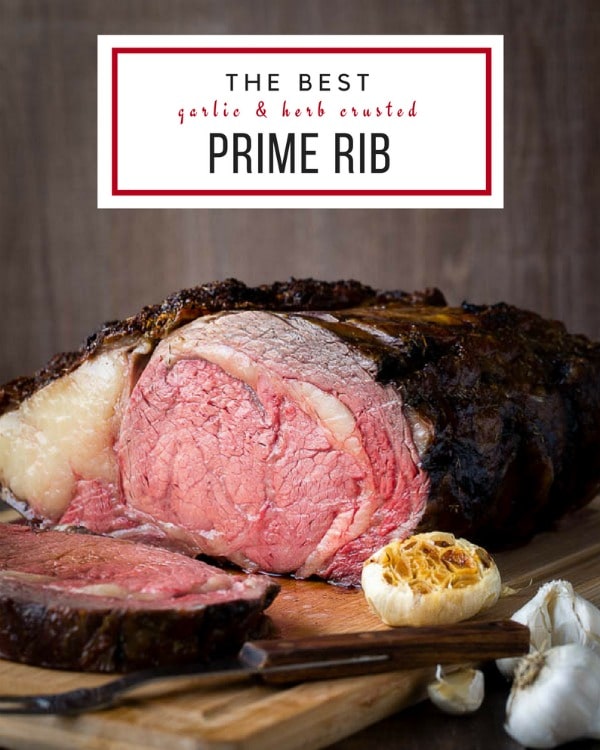
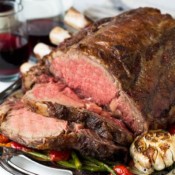
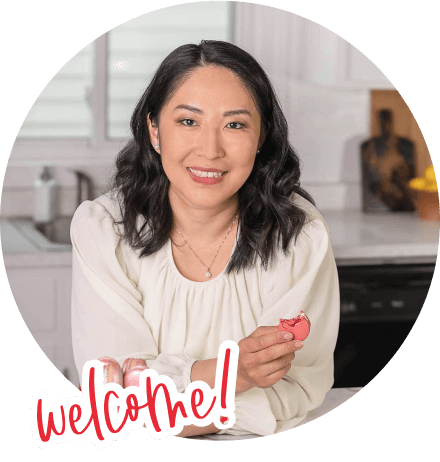
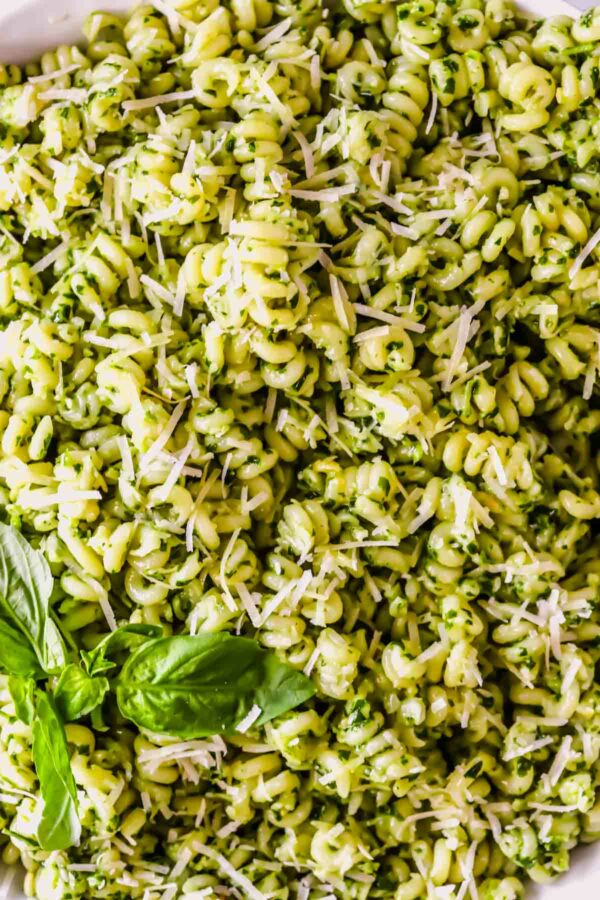
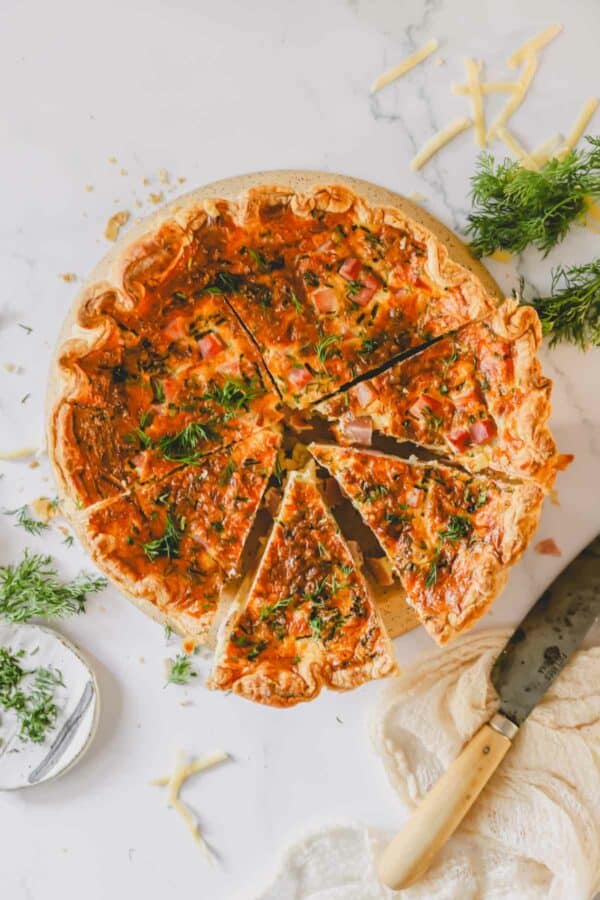
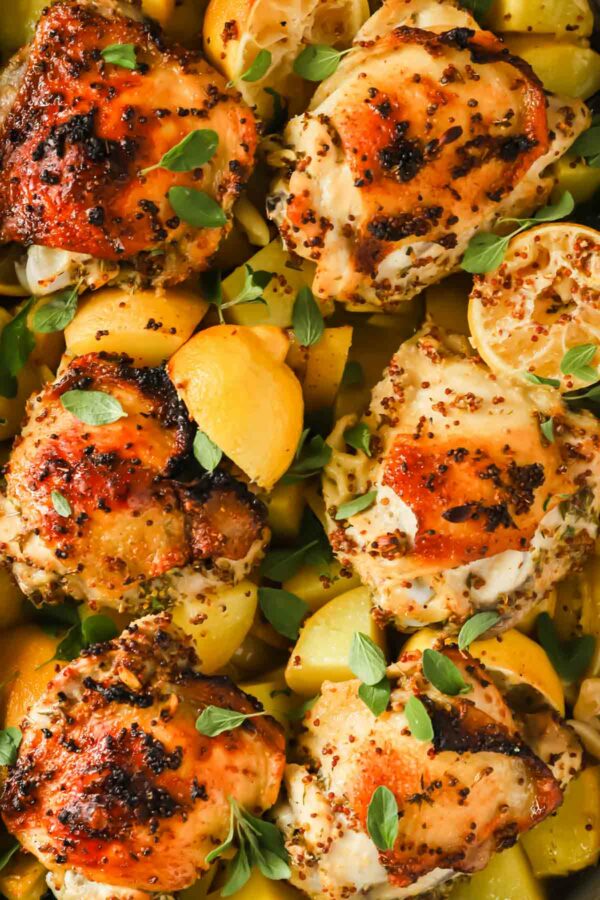
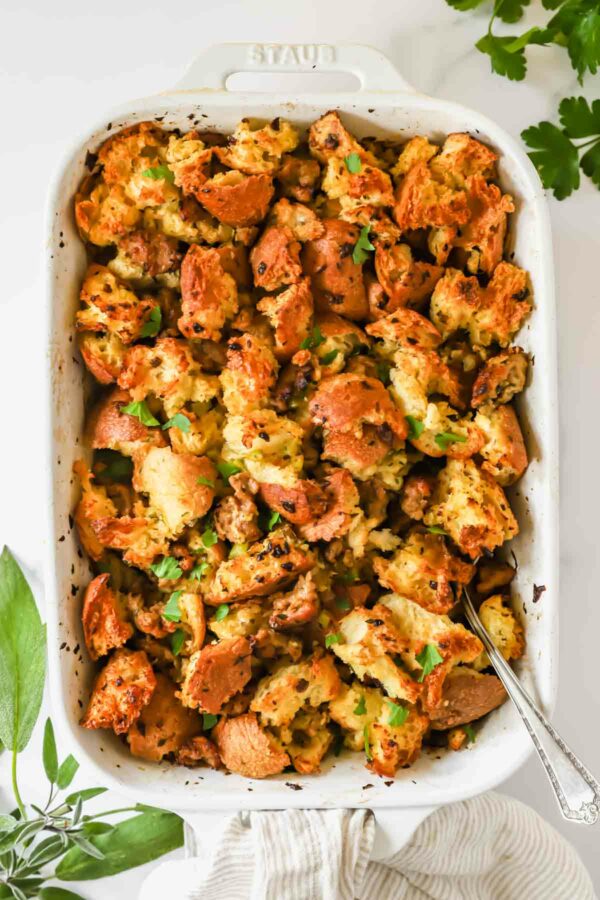

My 9.6 lb prime rib took 5.5 hours @ 200 degrees and another 10 mins @ 500 degrees to get to medium-rare. I did rest it for 30 mins before putting back in the oven for 10 mins @ 500 degrees. The outside of the roast had lots of flavor but the middle was a little bland. Next time I will rub the salt on at least 2-3 days in advance instead of overnight so the salt can penetrate more deeply inside the meat. I would definitely make this recipe again with the changes.
Hi, May! So happy you’ve tried the recipe and I appreciate your feedback and notes. I agree the earlier you salt the roast, the better.
How long at 500?
6-10 minutes, or until it’s nice and brown. Merry Christmas, Jakki!
Does this method produce sufficient pan drippings to make Yorkshire pudding?
Hi, Caren! No, actually it doesn’t produce much drippings with this method. All the juices stay in the meat. 🙂 Merry Christmas!
hi, i saw you wondered about yorkshire pudding? no there are not a lot of drippings but i put beef stock in the bottom of my pan, when i took the roast out of the oven the broth was dark and thickened a little so i used that. perfect yorkshire puddings, they were real tasty. good luck.
I am making my first prime rib tomorrow using your method. Can you please suggest some nice sides to go with this for Christmas dinner?
Hi, Tammy! Thanks for choosing my recipe for your holiday menu! So excited for you. So lots of great options for sides: scalloped potatoes and mashed potatoes are always perfect match for prime rib. I’m making scalloped potatoes. Also, this easy creamed corn and roasted butternut squash are great too. Merry Christmas!!
This cooking method makes sooo much sense! I’m cooking a 5 lb for tonight. I’m so excited i found your blog!! I do have one question though. I want to add Fresh Rosemary to the technique any suggestions on how to add it to the process? Also how do we seeve roasted garlic? Just spread on bread or roast? Thank you for all you do!
Hi, Susan. So happy you found my blog! Fresh rosemary sounds awesome. I’d chop it finely and mix it with the seasoning. And the rub it all over the roast, per direction. Roasted garlic is fantastic on bread. You can also add it in mashed potatoes, if you’re serving it. I don’t spread it on a roast though. Hope you all enjoy perfect prime rib. And let me know how it turns out, and share a pic if you get a chance. 🙂 Merry Christmas, Susan!
I am doing the same tonight with the rosemary. How long does a 5lb rib bake at 200?
Hi, Rae! Every oven is different, so it’s crucial to use a meat thermometer for precise timing. It’ll take about 3.5-4 hours at 200°F for bone-in rib. Hope this helps. Merry Christmas!
Where did you place your rack in the oven?
I placed the rack on 2 second rack from the bottom, otherwise it won’t fit in my oven. Hope this helps, Josh. Let me know your prime rib turns out, if you try it. Happy Holidays!
Do the asparagus and tomatoes go in to roast the entire time or just at the 500 degree time? Can’t wait to do this on a Christmas Eve!
Hi, Courtney! Asparagus and tomatoes will go only at the last roasting time at 500°F. Hope you’ll enjoy. Don’t forget to snap a pic and share it with me. Merry Christmas!
Would cooking times & temp be the same if I used an electric turkey roaster instead of my regular oven?
Hi, Rachel. To be honest, I have no experience with electric turkey roaster, so I have no idea how it compares with regular oven.
Hi!
How long should I cook a 14lb bone in roast? My first time making one this large for Christmas this year.
Thanks!!
Hi, Mary! I’d say to plan on for 4-4.5 hours at 200°F, but start checking the internal temperature at 3.5 hours mark. Hope you’ll enjoy that perfect prime rib. And let me know how it turns out. Merry Christmas!
Thanks so much for the quick reply! Will let you know after Christmas how it turns out. =)
Our 14lb Christmas toast turned out beautifully. Thank you!!!
Yay, so happy to hear that, Mary! Thanks for reporting back! Happy 2017!
Just one question do you need to cover the roast when baking at 200.
Hi, Coleen. No, covering isn’t necessary.